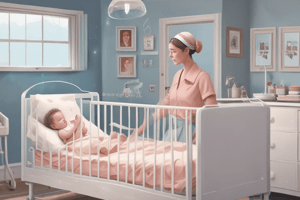Podcast
Questions and Answers
Match the following terms with their descriptions:
Match the following terms with their descriptions:
Surfactant = Helps prevent preterm infants' lungs from collapsing Intercostal muscles = Muscles between ribs involved in chest wall movement Diaphragm = Thin dome-shaped muscle separating abdomen from thorax Boyle’s Law = Gas law stating the inverse relationship between pressure and volume
Match the following statements with the correct process:
Match the following statements with the correct process:
Ventilation = Requires contraction of intercostal muscles and diaphragm Negative pressure breathing = Method used by humans to pull air into lungs Inhalation = Lung volume increases as rib muscles and diaphragm contract Exhalation = Lung volume decreases as rib muscles and diaphragm relax
Match the following lung characteristics with their corresponding descriptions:
Match the following lung characteristics with their corresponding descriptions:
Right lung = Has three lobes and is larger in size Left lung = Has two lobes and is smaller in size Human lungs = Not identical in structure, with different lobes for each side Surfactant treatment = Given to infants lacking endogenous surfactant production
Match the following terms with their roles in breathing:
Match the following terms with their roles in breathing:
Match the following steps of gas exchange with their descriptions:
Match the following steps of gas exchange with their descriptions:
Match the following respiratory surfaces with the animals they are found in:
Match the following respiratory surfaces with the animals they are found in:
Match the following terms with their definitions:
Match the following terms with their definitions:
Match the following gases with their direction of diffusion in gas exchange:
Match the following gases with their direction of diffusion in gas exchange:
Match the following actions with their effects on O2 and CO2 levels:
Match the following actions with their effects on O2 and CO2 levels:
Match the following concepts with their importance in gas exchange:
Match the following concepts with their importance in gas exchange:
Match the following actions with their corresponding effects during inhalation:
Match the following actions with their corresponding effects during inhalation:
Match the following actions with their corresponding effects during exhalation:
Match the following actions with their corresponding effects during exhalation:
Match the following terms with their definitions:
Match the following terms with their definitions:
Match the following muscle actions with their corresponding respiratory phases:
Match the following muscle actions with their corresponding respiratory phases:
Match the following statements with the correct respiratory process:
Match the following statements with the correct respiratory process:
Match the following terms with their roles in breathing:
Match the following terms with their roles in breathing:
Match the following with their definitions:
Match the following with their definitions:
Match the following with their percentages of CO2 transport in the blood:
Match the following with their percentages of CO2 transport in the blood:
Match the following statements with the correct Bohr shift direction:
Match the following statements with the correct Bohr shift direction:
Match the following factors with their effects on O2 binding/unloading by hemoglobin:
Match the following factors with their effects on O2 binding/unloading by hemoglobin:
Match the following with their roles in carbon dioxide transport:
Match the following with their roles in carbon dioxide transport:
Match the following components with their role in the oxygen-carrying capacity of blood:
Match the following components with their role in the oxygen-carrying capacity of blood:
Match the following statements about hemoglobin with their accuracy:
Match the following statements about hemoglobin with their accuracy:
Match the following factors with their influence on hemoglobin binding affinity to O2:
Match the following factors with their influence on hemoglobin binding affinity to O2:
Match the following terms with their description:
Match the following terms with their description:
Match the following properties with their impact on oxygen delivery:
Match the following properties with their impact on oxygen delivery:
Match the following descriptions with their relation to hemoglobin:
Match the following descriptions with their relation to hemoglobin:
What is the function of the endothelium in capillaries?
What is the function of the endothelium in capillaries?
How is cardiac output calculated?
How is cardiac output calculated?
When is blood pressure higher in the human body?
When is blood pressure higher in the human body?
What is the main factor that affects peripheral resistance?
What is the main factor that affects peripheral resistance?
What defines the Cardiac Output of an individual?
What defines the Cardiac Output of an individual?
Which term represents the volume of blood ejected during the contraction of the left ventricle?
Which term represents the volume of blood ejected during the contraction of the left ventricle?
What is the function of the atria in the mammalian heart?
What is the function of the atria in the mammalian heart?
Where does the left ventricle of the mammalian heart pump blood to?
Where does the left ventricle of the mammalian heart pump blood to?
Which valve separates the right atrium and ventricle in the mammalian heart?
Which valve separates the right atrium and ventricle in the mammalian heart?
What is the composition of the bicuspid (mitral) valve in the mammalian heart?
What is the composition of the bicuspid (mitral) valve in the mammalian heart?
In the mammalian heart, what separates the atria and ventricles into left and right chambers?
In the mammalian heart, what separates the atria and ventricles into left and right chambers?
Which chamber of the mammalian heart has a wall made up of thick myocardium?
Which chamber of the mammalian heart has a wall made up of thick myocardium?
What causes the heartbeat sound?
What causes the heartbeat sound?
In which circuit does blood move from the heart to the lungs?
In which circuit does blood move from the heart to the lungs?
What is the primary function of the systemic circuit in the human circulatory system?
What is the primary function of the systemic circuit in the human circulatory system?
Where does deoxygenated blood enter the human heart from?
Where does deoxygenated blood enter the human heart from?
Which side of the heart receives oxygenated blood?
Which side of the heart receives oxygenated blood?
What is the main function of the coronary circuit in the human circulatory system?
What is the main function of the coronary circuit in the human circulatory system?
What is the main cause of myocardial ischemia?
What is the main cause of myocardial ischemia?
Which condition results in thinner red blood cells due to reduced hemoglobin production?
Which condition results in thinner red blood cells due to reduced hemoglobin production?
What is the common name for a heart condition which occurs when blood flow stops to part of the heart, leading to permanent muscle damage?
What is the common name for a heart condition which occurs when blood flow stops to part of the heart, leading to permanent muscle damage?
Which genetic disease causes red blood cells to have a weaker cell membrane than usual?
Which genetic disease causes red blood cells to have a weaker cell membrane than usual?
How does sickle cell anemia affect the shape of red blood cells?
How does sickle cell anemia affect the shape of red blood cells?
What happens in the body when iron stores drop too low to support normal red blood cell production?
What happens in the body when iron stores drop too low to support normal red blood cell production?
What is the main difference between ischemic stroke and hemorrhagic stroke?
What is the main difference between ischemic stroke and hemorrhagic stroke?
Which blood vessel is responsible for carrying nutrient-rich blood from the digestive system to the liver?
Which blood vessel is responsible for carrying nutrient-rich blood from the digestive system to the liver?
What is an aneurysm and what part of the body can it affect?
What is an aneurysm and what part of the body can it affect?
Which blood vessels are responsible for taking blood away from the heart?
Which blood vessels are responsible for taking blood away from the heart?
What is the role of the inferior vena cava in the circulatory system?
What is the role of the inferior vena cava in the circulatory system?
How does deoxygenated blood reach the kidneys for filtration?
How does deoxygenated blood reach the kidneys for filtration?




